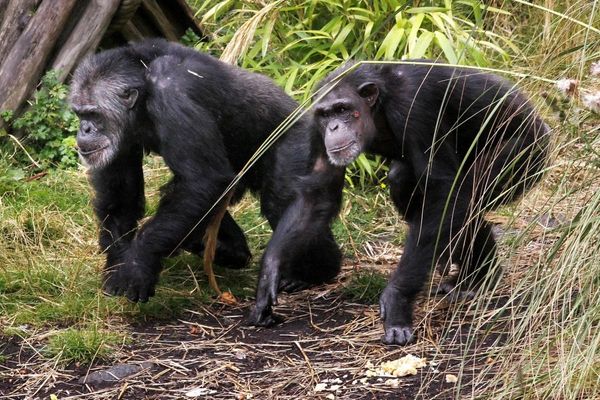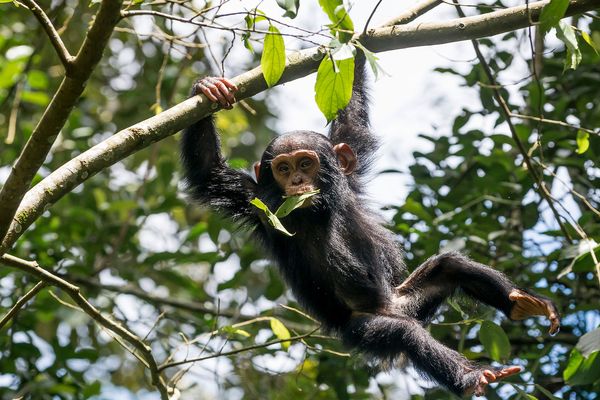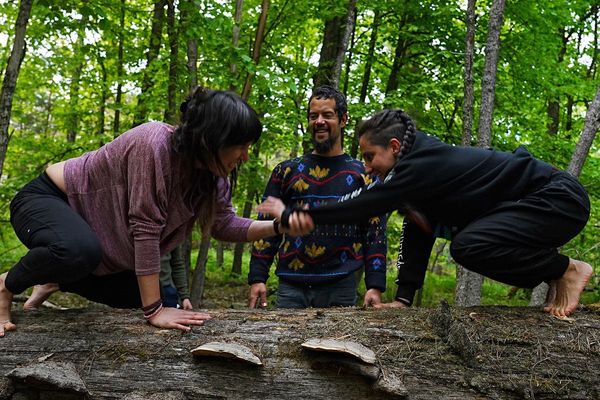
The rotating shoulders and extending elbows that allow humans to reach a high shelf or throw a ball may have first evolved as a natural braking system for our primate ancestors, a study suggests.
According to the researchers, early humans needed the movements to slow their descent out of trees so they could climb down without dying.
When early humans left forests for the grassy savanna, the researchers say, their versatile appendages were essential for gathering food and deploying tools for hunting and defence.
Researchers from Dartmouth College in the USA used sports-analysis and statistical software to compare videos and still-frames they took of chimpanzees and small monkeys called mangabeys climbing in the wild.
They found that the animals climb trees similarly, with shoulders and elbows mostly bent close to the body.
However, when climbing down chimpanzees extended their arms above their heads to hold onto branches like a person going down a ladder as their greater weight pulled them downward bottom-first.
Luke Fannin, first author of the study and a graduate student in Dartmouth’s Ecology, Evolution, Environment and Society programme, said the findings are among the first to identify the significance of “downclimbing” in the evolution of apes and early humans.
He added: “Our study broaches the idea of downclimbing as an undervalued, yet incredibly important factor in the diverging anatomical differences between monkeys and apes that would eventually manifest in humans.
“Downclimbing represented such a significant physical challenge given the size of apes and early humans that their morphology would have responded through natural selection because of the risk of falls.”
Co-author Jeremy DeSilva, professor and chairman of anthropology at Dartmouth, said: “Our field has thought about apes climbing up trees for a long time — what was essentially absent from the literature was any focus on them getting out of a tree. We’ve been ignoring the second half of this behaviour.
“The first apes evolved 20 million years ago in the kind of dispersed forests where they would go up a tree to get their food, then come back down to move on to the next tree.
Our study broaches the idea of downclimbing as an undervalued, yet incredibly important factor in the diverging anatomical differences between monkeys and apes that would eventually manifest in humans— Luke Fannin, First author
“Getting out of a tree presents all kinds of new challenges. Big apes can’t afford to fall because it could kill or badly injure them.
“Natural selection would have favoured those anatomies that allowed them to descend safely.”
The researchers suggest that flexible shoulders and elbows passed on from ancestral apes would have allowed early humans such as Australopithecus to climb trees at night for safety and come down in the daylight unscathed.
Once Homo erectus could use fire to protect itself from nocturnal predators, the human form took on broader shoulders capable of a 90-degree angle that made them excellent shots with a spear.
The researchers also studied the anatomical structure of chimp and mangabey arms using skeletal collections at Harvard University and The Ohio State University, respectively.
They found that, like people, chimpanzees have a shallow ball-and-socket shoulder that -while more easily dislocated – allows for a greater range of movement.
Also like humans, they can fully extend their arms thanks to the reduced length of the bone just behind the elbow known as the olecranon process.
Mangabeys and other monkeys are built more like quadrupedal animals such as cats and dogs, with deep pear-shaped shoulder sockets and elbows with a protruding olecranon process that make the joint resemble the letter L.
Although these joints are more stable, they have a much more limited flexibility and range of movement.
The research is published in the Royal Society Open Science journal.










